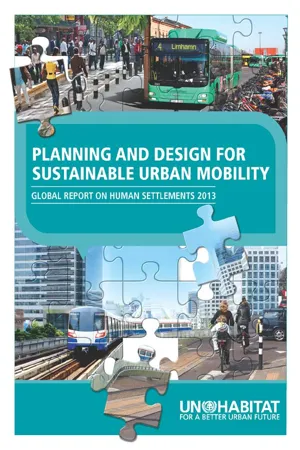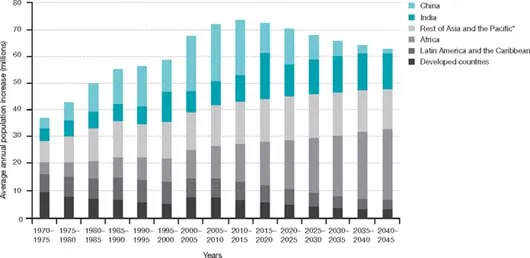![]()
|
|
THE URBAN MOBILITY CHALLENGE |
Hyper-mobility – the notion that more travel at faster speeds covering longer distances generates greater economic prosperity – seems to be a distinguishing feature of urban areas, where more than half of the world's population currently reside. By 2005, approximately 7.5 billion trips were made each day in cities worldwide.1 In 2050, there may be three to four times as many passenger-kilometres travelled as in the year 2000, infrastructure and energy prices permitting.2 Freight movement could also rise more than threefold during the same period.3 Mobility flows have become a key dynamic of urbanization, with the associated infrastructure invariably constituting the backbone of urban form. Yet, despite the increasing level of urban mobility worldwide, access to places, activities and services has become increasingly difficult. Not only is it less convenient – in terms of time, cost and comfort – to access locations in cities, but the very process of moving around in cities generates a number of negative externalities. Accordingly, many of the world's cities face an unprecedented accessibility crisis, and are characterized by unsustainable mobility systems.
This report examines the state of urban mobility in different parts of the world. It explores the linkages between urban form and mobility systems, with a view to determining the essential conditions for promoting the sustainable movement of people and goods in urban settings. This introductory chapter reviews key issues and concerns of urban mobility and provides a framework for the content of the rest of the report. It outlines development trends impacting on urban mobility and then discusses urban mobility issues of the twenty-first century, including the challenges of fostering sustain able mobility.
Current urbanization patterns are causing unprecedented challenges to urban mobility systems, particularly in developing countries. While these areas accounted for less than 40 per cent of the global population growth in the early 1970s, this share has now increased to 86 per cent, and is projected to increase to more than 100 per cent within the next 15 years, as the world's rural population starts to contract. What is perhaps even more striking is the regional patterns of urban population growth. Figure 1.1 shows how an increasing share of this growth is projected to occur in Africa (19 per cent of total annual growth today, compared to 43 per cent in 2045), while the combined annual urban population increase in developed countries, China, Latin America and the Caribbean is projected to decrease from 46 per cent of the total today to 11 per cent in 2045. Thus, it is the world's poorest regions that will experience the greatest urban population increase. These are the regions that will face the greatest challenges in terms of coping with increasing demands for improved transport infrastructure. In fact, projections indicate that Africa will account for less than 5 per cent of the global investments in transport infrastructure during the next few decades (see Table 8.2).
Despite the increasing level of urban mobility worldwide, access to places, activities and services has become increasingly difficult
A major point of departure for this report is that sustainable mobility extends beyond technicalities of increasing speed and improving the effectiveness and efficiency of transport systems, to include demand-oriented measures (e.g. promoting walking and cycling, and reducing the need to travel), with the latter representing a pivotal factor in achieving relevant progress. It suggests that the prevailing challenges of urban mobility are consequences of the preoccupation with the means of mobility rather than its end – which is the realization of accessibility.
Sustainable mobility extends beyond technicalities of increasing speed and improving the effectiveness and efficiency of transport systems, to include demand-oriented measures
This first chapter of the report starts with a discussion of the need to focus on access as the basis for urban mobility planning. It urges urban planners and decision-makers to move away from a ‘transport bias’ in urban mobility planning, towards a focus on the human right to equitable access to opportunities. This is followed by a brief analysis of global conditions and trends with respect to the urban movement of people and goods. The last part of the chapter provides a brief discussion of the social, environmental, economic and institutional dimensions of sustain ability in urban mobility systems.
Figure 1.1 Average annual urban population increase, by region (1970–2045)
Note: *The ‘rest of Asia and the Pacific’ includes all countries in this region except: Australia, China, India, Israel, Japan and New Zealand.
Source: UN, 2012a.
ACCESSIBILITY IS AT THE CORE OF URBAN MOBILITY
This report calls for a paradigm shift in transport policy
In directing attention beyond transport and mobility, and giving prominence to the aspect of accessibility, this report calls for a paradigm shift in transport policy. This alternative approach emphasizes the need to reduce the global preoccupation on mobility enhancement and infrastructure expansion. This kind of transportation planning has been implicated in problems of environmental degradation and social isolation. However, most fundamentally, a focus on mobility as a transportation-policy goal neglects the consensus view that the vast majority of trips are not taken for the sake of movement per se, but in order to reach destinations, or more broadly, to meet needs.
While the speed and efficiency of travel are important, more critical however, is the ease of reaching those destinations in terms of proximity, convenience as well as positive externalities
While the speed and efficiency of travel are important, more critical however, is the ease of reaching those destinations in terms of proximity, convenience as well as positive externalities. Transport and mobility as derived demands are treated as means for enabling people to access other people and places. Reducing the need for such demands and minimizing travel time also entails optimizing the value of being at the destination. Mobility is thus properly viewed as a means to the greater end of accessibility. Nonetheless, it is not the only means to this end: accessibility can be enhanced through proximity, as well as electronic connectivity. As a result, enhancing accessibility places human and spatial dimensions at the core of sustain able mobility.
This focus on accessibility emphasizes the need for a holistic and integrated approach to sustain able urban mobility. It establishes a link between urban form (in terms of shape, structure, function as well as demographics) and urban transportation systems. Particular attention is given to the urban form's potential to support the increased proximity of places and functions, thus minimizing the need for extended movement. Land-use planning ensures the proximity and compactness of locations, and diversifies functions, so as to cater to a variety of needs.
The accessibility focus for sustain able mobility also entails paying due consideration to the built form of the city, particularly the optimization of urban density and the fostering of a sense of place. The combination of high-density settlements, strong sense of place and mixed-used functions not only minimize the need for extended movement, but also enhance economies of agglomeration and encourage nonmotorized mobility. Furthermore, appropriate design and layout of streets and neighbourhoods, proper allowance for building configuration and density, and streamlined arrangement of arterial streets and roads, should also be taken into account. The backbone of accessibility-based urban mobility is public transport, particularly high-capacity public transport systems that are well integrated in a multinodal arrangement.
The bottom line for accessibility is not the hardware; rather it is the q...

